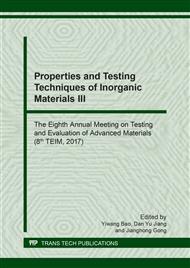[1]
K. Wang, H.P. Wu, Y.N. Meng, Z.X. Wei. Conducting polymer nanowire arrays for high performance supercapacitors. Small 2014, 10 , 14-31.
DOI: 10.1002/smll.201301991
Google Scholar
[2]
S. Zhang, N. Pan. Supercapacitors performance evaluation. Adv. Energy Mater. 2015, 5.
Google Scholar
[3]
X. Li, B. Wei. Supercapacitors based on nanostructured carbon. Nano Energy 2013, 2 , 159-173.
Google Scholar
[4]
J. Yan, Q. Wang, T. Wei, Z. Fan. Recent advances in design and fabrication of electrochemical supercapacitors with high energy densities. Adv. Energy Mater. 2008, 4 , 157-164.
DOI: 10.1002/aenm.201470017
Google Scholar
[5]
P. Simon, Y. Gogotsi. Materials for electrochemical capacitors. Nat. Mater. 2008, 7 , 845-854.
Google Scholar
[6]
M.D. Stoller, R.S. Ruoff. Best practice methods for determining an electrode material's performance for ultracapacitors. Energy & Environ. Sci. 2010, 3 , 1294-1301.
DOI: 10.1039/c0ee00074d
Google Scholar
[7]
B. Y. Zhu, S. Murali, W. Cai, X. Li, J. W. Suk, J. R. Potts, et al. Graphene and graphene oxide: synthesis, properties, and applications. Adv Mater 2010, 22:3906–24.
DOI: 10.1002/adma.201001068
Google Scholar
[8]
Y. Y. Peng, Y. M. Liu, J. K. Chang, C. H. Wu, M. D. Ger, N. W. Pu, et al. A facile approach to produce holey graphene and its application in supercapacitors. Carbon 2015, 81:347–56.
DOI: 10.1016/j.carbon.2014.09.067
Google Scholar
[9]
Y. Zhang, D. Li, X. Tan, B. Zhang, X. Ruan, H. Liu, et al. High quality graphene sheets from graphene oxide by hot-pressing. Carbon 2013, 54:143–8.
DOI: 10.1016/j.carbon.2012.11.012
Google Scholar
[10]
Z. S.Wu, W. Ren, D. W. Wang. High-Energy MnO2 Nanowire/Graphene and Graphene Asymmetric Electrochemical Capacitors. ACS Nano. 2010, 4 , 5835-5842.
DOI: 10.1021/nn101754k
Google Scholar
[11]
F. L. Jia, L. Z. Zhang, X. Y. Shang, et al.. Non-aqueous sol-gel approach towards the controllable synthesis of nickel nanospheres, nanowires, and nanoflowers. Adv. Mater. 2008, 20, 1050–1054.
DOI: 10.1002/adma.200702159
Google Scholar
[12]
D. Zitoun, N. Pinna, N. Frolet, C. Belin. Single crystal manganese oxide multipods by oriented attachment. J. Am. Chem. Soc. 2005, 127 , 15034-15035.
DOI: 10.1021/ja0555926
Google Scholar
[13]
H. M. Chen, J. M. He, C. B. Zhang, H. He. Self-assembly of novel mesoporous manganese oxide nanostructures and their application in oxidative decomposition of formaldehyde. J. Phys. Chem. C 2007, 111 , 18033-18038.
DOI: 10.1021/jp076113n
Google Scholar
[14]
Y. S. Ding, X. F. Shen, S. Sithambaram, S. Gomez, R. Kumar, V. M. Crisostomo, S. L. Suib, M. Aindow. Synthesis and catalytic activity of cryptomelane-type manganese dioxide nanomaterials produced by a novel solvent-free method. Chem. Mater. 2005, 17 , 5382-5389.
DOI: 10.1021/cm051294w
Google Scholar
[15]
R. Liu, S. B. Lee. MnO2/Poly(3,4-ethylenedioxythiophene) coaxial nanowires by one-step coelectrodeposition for electrochemical energy storage. J. Am. Chem. Soc. 2008, 130, 2942-2943.
DOI: 10.1021/ja7112382
Google Scholar
[16]
L. P. Zhu, H. M. Xiao, W. D. Zhang, Y. Yang, S. Y. Fu. Synthesis and characterization of novel three-dimensional metallic Co dendritic superstructures by a simple hydrothermal reduction route. Cryst. Growth Des. 2008, 4 ,1113-1118.
DOI: 10.1021/cg701036k
Google Scholar
[17]
G. P. Wang, L. Zhang, J.J. Zhang. A review of electrode materials for electrochemical supercapacitors. Chem. Soc. Rev. 2012, 41, 797-828.
DOI: 10.1039/c1cs15060j
Google Scholar
[18]
H. L. Li, L. X. Jiang, Q. L. Cheng, et al. MnO2 nanoflakes@hierarchical porous carbon nano- composites for high-performance supercapacitor electrodes. Electrochim. Acta, 2015, 164, 252-259.
DOI: 10.1016/j.electacta.2015.02.218
Google Scholar
[19]
D. Hou, H. S. Tao, X. Z. Zhu, M. G. Li. Polydopamine and MnO2 core-shell composites for high-performance supercapacitors. Appl. Surf. Sci., 2017, 419, 580-585.
DOI: 10.1016/j.apsusc.2017.05.080
Google Scholar
[20]
W. S. Hummers, R. E. Offeman. Preparation of graphitic oxide. J. Am. Chem. Soc. 1958, 80, 1339.
DOI: 10.1021/ja01539a017
Google Scholar
[21]
Y. Chen, X. Zhang, P. Yu, et al. Stable dispersions of graphene and highly conducting graphene films: a new approach to creating colloids of graphene monolayers. Chem. Commun. 2009, 30, 4527-4529.
DOI: 10.1039/b907723e
Google Scholar


